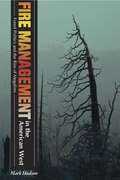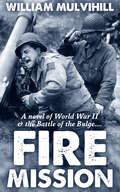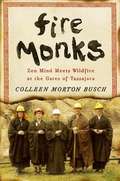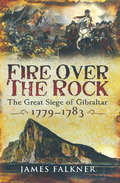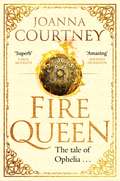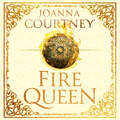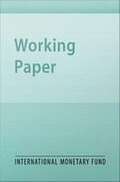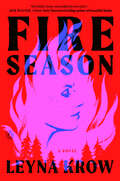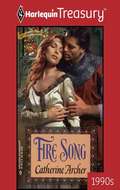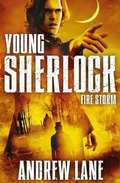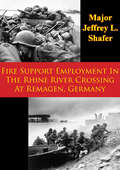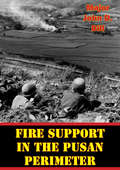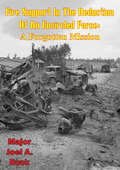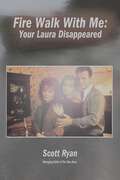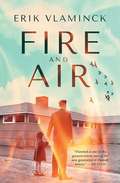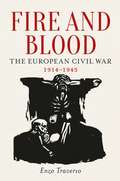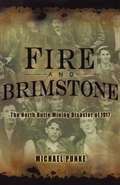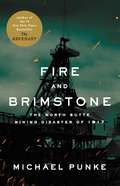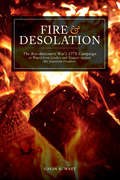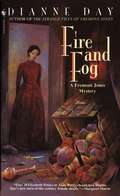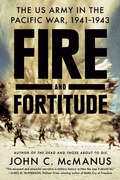- Table View
- List View
Fire Management in the American West
by Mark HudsonMost journalists and academics attribute the rise of wildfires in the western United States to the USDA Forest Service's successful fire-elimination policies of the twentieth century. However, in Fire Management in the American West, Mark Hudson argues that although a century of suppression did indeed increase the hazard of wildfire, the responsibility does not lie with the USFS alone. The roots are found in the Forest Service's relationships with other, more powerful elements of society--the timber industry in particular. Drawing on correspondence both between and within the Forest Service and the major timber industry associations, newspaper articles, articles from industry outlets, and policy documents from the late 1800s through the present, Hudson shows how the US forest industry, under the constraint of profitability, pushed the USFS away from private industry regulation and toward fire exclusion, eventually changing national forest policy into little more than fire policy. More recently, the USFS has attempted to move beyond the policy of complete fire suppression. Interviews with public land managers in the Pacific Northwest shed light on the sources of the agency's struggles as it attempts to change the way we understand and relate to fire in the West. Fire Management in the American West will be of great interest to environmentalists, sociologists, fire managers, scientists, and academics and students in environmental history and forestry.
Fire Mission
by William MulvihillFire Mission, first published in 1957, is a fictional account of a field artillery battery beginning just before the Battle of the Bulge (December 1944), to the capture of the bridge at Remagen in March, 1945. As the author served in an artillery battery during the Battle of the Bulge, his writing accurately portrays the lives of the soldiers living through the cold, filth, and death of this epic battle near the end of the war. William Mulvihill would later write the best-selling novel, The Sands of Kalahari, made into a motion picture in 1965.
Fire Monks: Zen Mind Meets Wildfire
by Busch Colleen MortonA San Francisco Chronicle Best Book of the Year A Publishers Weekly Best Book of the Year In June 2008 more than two thousand wildfires, all started by a single lightning storm, blazed across the state of California. Tassajara, the oldest Zen Buddhist monastery in the United States, was at particular risk. Set deep in the Ventana wilderness north of Big Sur, the center is connected to the outside world by a single unpaved road. If fire entered the canyon, there would be no way out. Disaster struck during the summer months, when Tassajara opens its doors to visitors, and the grounds fill with guests expecting a restful respite. Instead, the mountain air filled with smoke, and monks broke from regular meditation to conduct fire drills. All visitors were evacuated, and many Zen students followed. A small crew of residents and firefighters remained, preparing to defend Tassajara. But nothing could have prepared them for what came next. When a treacherous shift in weather conditions brought danger nearer still, firefighters made the flash decision to completely evacuate the monastery. As the firefighters and remaining residents caravanned out the long road to Tassajara, five monks turned back, risking their lives to save the monastery. Fire Monks is their story. A gripping narrative as well as an insider’s portrait of the Zen path, Fire Monks reveals what it means to meet an emergency with presence of mind. In tracking the four men and one woman who returned-all novices in fire but experts in readiness-we witness them take their unique experiences facing the fires in their own lives and apply that wisdom to the crisis at hand. Relying on their Zen training, the monks accomplished the seemingly impossible-greeting the fire not as an enemy to defeat, but as a friend to guide. Fire Monks pivots on the kind of moment some seek and some run from, when life and death hang in simultaneous view. Drawing on the strength of community, the practice of paying attention, and the power of an open, flexible mind, the Tassajara monks were able to remain in the moment and act with startling speed and clarity. In studying an event marked by great danger and uncertainty, Fire Monks reveals the bravery that lives within every heart. .
Fire Over the Rock: The Great Siege of Gibraltar, 1779–1783
by James Falkner&“This book does a wonderful job in describing a portion of [the Rock of Gibraltar&’s] history during the Napoleonic Wars&” (The Past in Review). The great siege of Gibraltar was the longest recorded in the annals of the British army. Between 1779 and 1783, a small British force defended the Rock against the Spanish and the French who were determined take this strategically vital point guarding the entrance to the Mediterranean. The tenacity and endurance shown by the attackers and defenders alike, and the sheer ingenuity of the siege operations mounted by both sides, make the episode an epic of military history, and the story gives us a fascinating insight into the realities of siege warfare. In this, the first full study of the siege for over forty years, James Falkner draws on a wide range of contemporary sources to tell the exciting tale of a huge and complex operation.
Fire Queen: Shakespeare's Ophelia as you've never seen her before . . . (Shakespeare's Queens)
by Joanna CourtneyLover or leader? Weakling or warrior? Madwoman or misfit?Escape into the untold story of Shakespeare's Ophelia . . . As a young girl, Ofelia stood frozen as her mother threw herself on her father's funeral pyre. Such is the fate, she learned, of the devoted wife and in that moment, she swore never to belong to any man. Years later, she is a force to be reckoned with: right hand woman to the newly crowned Prince Hamlet, to whom she has sworn her sword and her undying loyalty, but refuses his true desire . . . her hand in marriage.When Hamlet's jealous uncle plots against him, Ofelia will have to use every wile at her disposal to keep her prince safe from those who wish him harm. Yet in the end, it could be her unruly heart that is the greatest betrayer of all.A brand new Historical fiction series by the bestselling author of the Queens of Conquest series, her new trilogy unearths the real women behind Shakespeare's most infamous queens . . . If you love Elizabeth Chadwick and Anne O'Brien you will adore Joanna CourtneyPraise for Joanna Courtney: 'A glorious, rich, epic story of love, friendship and sacrifice which will sweep you up and transport you to another time. I absolutely loved this and can't wait for the next book in the series' Rachael Lucas, author of Sealed With A Kiss and Coming Up Roses 'Lovely writing and a terrific sense of narrative drive. Superb!' Carol McGrath, author of The Daughters of Hastings trilogy
Fire Queen: Shakespeare's Ophelia as you've never seen her before . . . (Shakespeare's Queens)
by Joanna CourtneyLover or leader? Weakling or warrior? Madwoman or Misfit?Escape into the untold story of Shakespeare's Ophelia . . . As a young girl, Ofelia stood frozen as her mother threw herself on her father's funeral pyre. Such is the fate, she learned, of the devoted wife and in that moment, she swore never to belong to any man. Years later, she is a force to be reckoned with: right hand woman to the newly crowned Prince Hamlet, to whom she has sworn her sword and her undying loyalty, but refuses his true desire . . . her hand in marriage.When Hamlet's jealous uncle plots against him, Ofelia will have to use every wile at her disposal to keep her prince safe from those who wish him harm. Yet in the end, it could be her unruly heart that is the greatest betrayer of all.A brand new Historical fiction series by the bestselling author of the Queens of Conquest series, her new trilogy unearths the real women behind Shakespeare's most infamous queens . . . If you love Elizabeth Chadwick and Anne O'Brien you will adore Joanna CourtneyPraise for Joanna Courtney: 'A glorious, rich, epic story of love, friendship and sacrifice which will sweep you up and transport you to another time. I absolutely loved this and can't wait for the next book in the series' Rachael Lucas, author of Sealed With A Kiss and Coming Up Roses'Lovely writing and a terrific sense of narrative drive. Superb!' Carol McGrath, author of The Daughters of Hastings trilogy
Fire Sales and the Financial Accelerator
by David Cook Woon Gyu ChoiA report from the International Monetary Fund.
Fire Season: A Novel
by Leyna Krow"Devilishly funny and endlessly inventive." —Jess Walter, #1 New York Times bestselling author Beautiful Ruins A Publisher&’s Weekly Summer Reads Staff Pick One of Lit Hub&’s &“35 Novels You Need to Read This Summer&” "In this enthralling debut, Leyna Krow brings us the story of three misfits, united by fire, each living out a dream (or nightmare) of the American West. It&’s an arresting take on magic, science, disaster, and salvation that&’s eerily resonant with the fire seasons we find ourselves living through today." —Anna North, author of Reese&’s Book Club Pick and New York Times bestseller Outlawed "This story is darkly funny, deliciously devious and hugely inventive, a magical twist on the allure of the American West and who goes there to seek their fortune." —Good Housekeeping, "The 30 Best and Most Anticipated Books of 2022 (So Far)" The propulsive story of three scheming opportunists—a banker, a conman, and a woman with an extraordinary gift—whose lives collide in the wake of a devastating fire in the American WestFor the citizens of Spokane Falls, the fire of 1889 that destroyed their frontier boomtown was no disaster; it was an opportunity. Barton Heydale, manager of the only bank in Spokane Falls, is on the verge of ending his short, unpopular life. But when his city goes up in flames, he sees an ember of hope shimmering on the horizon, headed right for him. As citizens flock to the bank to cash out insurance policies and take out loans, he realizes he can command the power he craves—and it&’s not by following the rules. Here is his reason to live. When Quake Auchenbaucher, a career con man hired to investigate the cause of the fire, arrives in Spokane Falls, he employs his usual shady tactics. But this time, with Washington Territory vying for statehood, the sudden attention to due process jeopardizes Quake&’s methods of manipulation. And then there&’s Roslyn Beck, whose uncanny ability to see the future has long driven her to drink, and with whom both Barton and Quake have fallen madly and dangerously in love. She is known as a &“certain kind of woman,&” in possession of unique talents and influence, if only she can find the right ways to wield them. As their paths collide, diverge, and collide again, Barton, Quake, and Roslyn come to terms with their own needs for power, greed, and control, leading one to total ruin, one to heartbreak, and one, ultimately, to redemption. With masterful precision, devious originality, and dark whimsy, Fire Season freshly imagines the greed and misogyny of the American West to tell a rollicking, bewitching story about finding purpose in the face of injustice.
Fire Song
by Catherine ArcherThe Wrong Bride To the dashing Roland St. Sebastian, a king-decreed marriage to the biddable daughter of his enemy was bad enough…but when the blushing bride turned out to be her spitfire sister, Meredyth, Roland's wrath was boundless. And though the redheaded vixen's kisses drove him nearly mad with yearning, he wondered if he would ever learn to trust her—or if he was destined to live a life of loneliness with the woman he loved.
Fire Song (Medieval Song Quartet #2)
by Catherine CoulterCoulter's medieval melody continues-second in the song series. Lord Graelam de Moreton is willing to accept his new bride, Kassia, as she appears-innocent and guileless. But appearances can be deceiving...
Fire Spook: The Mysterious Nova Scotia Haunting (Stories of Our Past)
by Monica Graham&“A fascinating look at the misery of unexplained events and other people&’s reactions to the events visited on a seemingly happy family.&” —The New Glasgow News Just below the Antigonish-Guysborough County line, there is an overgrown spot, nearly impossible to find without a guide, where the cursed MacDonald farm once stood. Though no physical trace remains, the legend of the mysterious events that once took place lives on. In the newest addition to the Stories of Our Past series, Monica Graham exposes the fascinating history behind the fire-spook of Caledonia Mills, Nova Scotia, a true story that spread as quickly and uncontrollably as the flames that started it all. But were these spontaneous fires and sinister sightings the work of a poltergeist, or of a troubled young woman? &“A very good book to purchase if you want to read about the case, case notes, and view photos of the family and all of the investigators that took part in trying to unravel the mystery that the family was going through.&” —Paranormal Investigations Nova Scotia &“Graham deftly tries her hand at explaining the unexplainable . . . compelling, eyewitness accounts of the fires that plagued the family are recounted by Graham . . . [an] entertaining, well-written book.&” —The New Glasgow News
Fire Storm (Young Sherlock #4)
by Andrew LaneIn Fire Storm by Andrew Lane, young Sherlock's friend and her father have vanished. Their house looks as if nobody has ever lived in it; the neighbors claim never to have heard of them. Sherlock begins to doubt his sanity, until a clever clue points him to Scotland. Following that clue leads him into a mystery that involves kidnapping, bodysnatchers, and a man who claims he can raise the dead. Only the budding detective Sherlock can untangle the mind-bending--and dangerous--puzzles that ensnare his friends. Think you know Sherlock Holmes? Think again!
Fire Support Bases Vietnam: Australian and Allied Fire Support Base Locations and Main Support Units
by Bruce PickenFire Support Bases Vietnam is a meticulous documentation of the construction, location and role of fire support bases during the Vietnam War, compiled by Vietnam veteran Bruce Picken. Often makeshift bases hacked out of primary jungle, these artillery gun areas provided essential support to infantry field units during operations in South Vietnam. In its simplest sense, a fire support base was an often hastily constructed fortified artillery base position, usually sited forward close to the centre of the area of operations in support of task force, battalion or company operations. The role of the fire support base was to bring artillery and mortar fire within range of friendly forces operating in depth. Artillery gun areas were not unique to the Vietnam conflict. In previous wars they were deployed in allied territory to cover the front lines and to support advancing troops. The concept was first applied in Vietnam by US forces and quickly adapted by Australian forces arriving in Phuoc Tuy Province in May 1966 to fight a new kind of war. This conflict was not like its predecessors and the fire support bases were now more usually sited in territory dominated by the enemy to provide much-needed protection for forces operating in bitterly contested areas. Fire Support Bases Vietnam is a detailed account that identifies every fire support base by date, location and role and provides an outline of the operations in which they participated. This is an essential reference book for those with a serious interest in the Vietnam War, and adds valuable detail to the study of a campaign that occupies a unique place in the Australian psyche.
Fire Support Employment In The Rhine River Crossing At Remagen, Germany
by Major Jeffrey L. ShaferThis study is an historical analysis of the procedures and doctrine used by the III Corps Artillery during the First U.S. Army's crossing of the Rhine River at Remagen, Germany. This study examines the actions of III Corps Artillery in the employment, organization for combat, and command and control of artillery units at Remagen. The fire support procedures employed by the field artillery are compared with those prescribed by published doctrine and unit standing operating procedures. This comparison is used to evaluate the adequacy of doctrine and the need for standing operating procedures to supplement the published doctrine. The development of standing operating procedures from lessons learned during earlier combat is examined to show how the doctrine allowed flexibility and standardization that was evident throughout the army. This standardization continues to serve as a model for fire support operations in today's emerging combined arms doctrine.The study concludes with lessons learned: (1) Centralized command and control of field artillery should be under the headquarters that is best organized to control a large number or units, (2) doctrine and standing operating procedures are useless unless leaders develop and execute plans that are in accordance with the principles established and practiced, (3) the tendency to establish standing operating procedures that violate or contradict doctrine should be avoided, (4) a need for more liaison officers was evident at Remagen as well as through the war and continues to exist today even with improved technology, (5) the redundancy of tasks outlined in doctrine provides the flexibility needed to accomplish the fire support mission during a fast moving battle, and (6) field artillery units should practice several tactical missions and not just the standard mission associated with peace time organizations.
Fire Support In The Pusan Perimeter
by Major John D. DillFive years after emerging victorious from World War II, the United States became embroiled in the Korean War. In August of 1950, despite the relative industrial and technological disadvantages suffered by the enemy North Korean Peoples' Army, the American Eighth Army was nearly defeated and pushed into the sea while trying to defend a toehold on the Korean peninsula around the port of Pusan. The poorly trained and equipped U.S. soldiers and marines defending the Pusan Perimeter relied heavily on fire support assets to stem the tide and defeat the North Korean attack.This monograph asks if the fire support, including both artillery and air fires, provided to the Eighth Army Infantry and Armor units was effective. It also examines the reasons for the success or failures of fire support by contrasting the use of fire support by different Army and Marine Corps units as they defended the perimeter. Additionally, the monograph addresses the question of how the force development process shaped the success or failure of the Pusan fire support effort. Finally, the monograph discusses lessons from the Pusan defense that are applicable to current fire support and force development.The monograph concludes that the fire support effort in the Pusan campaign was effective. However, because of the force reductions and training lapses that occurred after World War II in the United States Army and Air Force, it was not as effective as it could have been. The time taken to relearn the lessons of World War II and to rebuild units to doctrinal war time strength needlessly cost lives. The Pusan perimeter fight contains valuable lessons for current fire support leaders as they grapple with challenges similar to those faced by their predecessors in the summer of 1950.
Fire Support in the Reduction of an Encircled Force - a Forgotten Mission
by Major Joel A. BuckUsing historical analysis and survey, this study examines the sufficiency of U.S. field artillery doctrine, tactics, and techniques to support the destruction of an encircled enemy. Focus is on identifying existing weaknesses by comparing applicable lessons learned from history with the practices spelled out in current manuals. The Allied attempt to encircle and reduce the German forces within the Falaise-Argentan pocket in central France during August 1944 and the Soviet Belorussian Offensive and subsequent encirclement and reduction of German forces during June 1944 are examined. The results of a survey completed by the V and VII U.S. Corps artillery commanders on the subject are also included.Among the shortfalls identified are: current attention is more focused on breaking out of an encirclement than on forming an encirclement; when encircling an enemy is addressed, discussion stops after the encirclement is formed and before reduction begins; field artillery procedures do not separately address this mission; friendly or enemy use of chemical or nuclear weapons has not been considered; the requirement to simultaneously support reduction and exploitation operations has not been addressed; there is a need for an artillery commander at echelons above corps.The study concludes that the process of reducing a large encircled enemy force is sufficiently different from other operations that it should be separately addressed. Although the "doing" of the component parts of the artillery aspect of this operation are doctrinally established, tying them together into a synergetic package requires innovative attention. Resulting field artillery doctrine, tactics, and techniques derived are equally applicable in reducing an isolated enemy force that has broken through or been Inserted Into our rear area as they are in the reduction of an offensively encircled enemy.
Fire Under My Feet: History, Race, and Agency in African Diaspora Dance (Routledge Series in Equity, Diversity, and Inclusion in Theatre and Performance)
by Ofosuwa M. AbiolaFire Under My Feet seeks to expose the diverse, significant, and often under-researched historical and developmental phenomena revealed by studies in the dance systems of the African Diaspora. In the book, written documentation and diverse methodologies are buttressed by the experiences of those whose lives are built around the practice of African diaspora dance. Replete with original perspectives, this book makes a significant contribution to dance and African diaspora scholarship simultaneously. Most important, it highlights the work of researchers from Ecuador, India, Puerto Rico, the United States, and the United Kingdom, and it exposes under-researched and omitted voices of the African diaspora dance world of the aforesaid locations and Puerto Rico, Columbia, and Trinidad as well. This study showcases a blend of scholars, dance practitioners, and interdisciplinarity, and engages the relationship between African diaspora dance and the fields of history, performance studies, critical race theory, religion, identity, and black agency.
Fire Walk With Me: Your Laura Disappeared
by Scott RyanDavid Lynch expert Scott Ryan takes a deep dive into one of the filmmaker's most controversial works, Twin Peaks: Fire Walk With Me, relying largely on original interviews with cast and creative team members (including Laura Palmer herself, Sheryl Lee) that offer brand-new information and insights into the film."Scott Ryan's heartfelt interest and thoughtful curiosity have created a place where the story of these characters continues to live on and evolve as the decades go by." —Sheryl Lee, actress "Scott Ryan's writing and understanding of my music is unreal." —Angelo Badalamenti, composer of the Fire Walk With Me score In 1990, David Lynch was on top of the world. Wild at Heart won the Palme d'Or at the Cannes Film Festival and Twin Peaks was the hottest show on TV. In 1992, he released Twin Peaks: Fire Walk with Me. It sure is amazing how fast coffee can get cold. The film was not well received, to say the least, by critics or ticket buyers. It seemed like the verdict was in: Twin Peaks was dead and wrapped in plastic. Thirty years later, the film is thought by many to be Lynch&’s masterpiece. The book features brand new interviews with editor Mary Sweeney, Gregg Fienberg, DP Ron Garcia, lead actress Sheryl Lee, and interview clips from Writer Bob Engels, lead actor Ray Wise, and other cast members, as well as Ryan&’s essays covering the different iterations of the script, Angelo Badalamenti&’s superb score, the fandom, and the lore of the The Missing Pieces. The book has a foreword by Entertainment Weekly's Twin Peak Podcast host Jeff Jensen (HBO's Watchmen).
Fire and Air
by Erik VlaminckTold from the points of view of a mother and daughter, Fire and Air tells the story of a Belgian and Dutch family who flee to Canada to escape the Second World War, only to have the past catch up to them.Ten-year-old Elly Verkest is a first-generation immigrant to Canada. Her father, Gaston, is one of the many Belgians who moved to the country after the Second World War, and her mother, Mina, is from Zundert, a small town in the Netherlands. When Gaston goes on one of his trips to his hometown of Flanders, he doesn’t come back. As each struggles with the sudden disappearance of Gaston, mother and daughter grow farther apart. When she is a young adult, Elly decides to search for her father in Belgium. There, she discovers that Gaston has a secret life.When Elly returns to Canada, she finds out she is pregnant by a man she met in Atwerp. Several years later, Elly’s daughter, Linda, develops a close relationship with her grandmother. Slowly, she discovers all of the family secrets…
Fire and Blood: The European Civil War, 1914-1945
by David Fernbach Enzo TraversoEurope's second Thirty Years' War--an epoch of blood and ashesFire and Blood looks at the European crisis of the two world wars as a single historical sequence: the age of the European Civil War (1914-1945). Its overture was played out in the trenches of the Great War; its coda on a ruined continent. It opened with conventional declarations of war and finished with "unconditional surrender." Proclamations of national unity led to eventual devastation, with entire countries torn to pieces. During these three decades of deepening conflicts, a classical interstate conflict morphed into a global civil war, abandoning rules of engagement and fought by irreducible enemies rather than legitimate adversaries, each seeking the annihilation of its opponents. It was a time of both unchained passions and industrial, rationalized massacre. Utilizing multiple sources, Enzo Traverso depicts the dialectic of this era of wars, revolutions and genocides. Rejecting commonplace notions of "totalitarian evil," he rediscovers the feelings and reinterprets the ideas of an age of intellectual and political commitment when Europe shaped world history with its own collapse.
Fire and Brimstone
by Michael PunkeThere is a sign that appears to point persistently to a terrible explosion underground. -HOROSCOPE PRINTED IN THE ANACONDA STANDARD, JUNE 5, 1917
Fire and Brimstone: The North Butte Mining Disaster of 1917
by Michael PunkeThe author of the #1 New York Times bestseller, The Revenant--basis for the award-winning motion picture starring Leonardo DiCaprio--tells the remarkable story of the worst hard-rock mining disaster in American history. The worst hard-rock mining disaster in American history began a half hour before midnight on June 8, 1917, when fire broke out in the North Butte Mining Company's Granite Mountain shaft. Sparked more than two thousand feet below ground, the fire spewed flames, smoke, and poisonous gas through a labyrinth of underground tunnels. Within an hour, more than four hundred men would be locked in a battle to survive. Within three days, one hundred and sixty-four of them would be dead.Fire and Brimstone recounts the remarkable stories of both the men below ground and their families above, focusing on two groups of miners who made the incredible decision to entomb themselves to escape the gas. While the disaster is compelling in its own right, Fire and Brimstone also tells a far broader story striking in its contemporary relevance. Butte, Montana, on the eve of the North Butte disaster, was a volatile jumble of antiwar protest, an abusive corporate master, seething labor unrest, divisive ethnic tension, and radicalism both left and right. It was a powder keg lacking only a spark, and the mine fire would ignite strikes, murder, ethnic and political witch hunts, occupation by federal troops, and ultimately a battle over presidential power.
Fire and Desolation: The Revolutionary War's 1778 Campaign as Waged from Quebec and Niagara Against the American Frontiers
by Gavin K. WattFollowing a disastrous campaign in 1777, the alliance between the Six Nations and the British Crown became seriously strained. Relations were made even more difficult by the hands-off stance of Quebec’s governor, General Guy Carleton, which led to the Native leaders developing their own strategies and employing traditional tactics, leading to a ferocious series of attacks on the frontiers of Vermont, New York, and Pennsylvania, supported by Loyalist and Regular troops. Among these were two infamous actions, referred to as “massacres” by American historians — attacks on the Wyoming and Cherry Valleys. This destructive campaign prompted the Continental Congress to mount three major retributive expeditions against the territories of the Six Nations and their allies the following year. In Fire and Desolation, Gavin Watt details individual historical conflicts, illustrates the crushing tactical expertise of the Senecas and their Loyalist allies, and provides a fresh perspective on Canada’s involvement in the American Revolution and the unfolding events of 1778.
Fire and Fog
by Dianne DayIn this follow-up to The Strange Files of Fremont Jones, the intrepid investigator finds herself in the midst of the 1906 San Francisco earthquake. In the unnerving mayhem and devastation of the ensuing fires, she learns to drive, is pursued by two ardent suitors, falls for her sleuthing cohort, and makes a discovery that could end her life.
Fire and Fortitude: The US Army in the Pacific War, 1941-1943
by John C. McManusAn engrossing, epic history of the US Army in the Pacific War, from the acclaimed author of The Dead and Those About to Die“This eloquent and powerful narrative is military history written the way it should be.”—James M. McPherson, Pulitzer Prize-winning historian "Out here, mention is seldom seen of the achievements of the Army ground troops," wrote one officer in the fall of 1943, "whereas the Marines are blown up to the skies." Even today, the Marines are celebrated as the victors of the Pacific, a reflection of a well-deserved reputation for valor. Yet the majority of fighting and dying in the war against Japan was done not by Marines but by unsung Army soldiers. John C. McManus, one of our most highly acclaimed historians of World War II, takes readers from Pearl Harbor—a rude awakening for a military woefully unprepared for war—to Makin, a sliver of coral reef where the Army was tested against the increasingly desperate Japanese. In between were nearly two years of punishing combat as the Army transformed, at times unsteadily, from an undertrained garrison force into an unstoppable juggernaut, and America evolved from an inward-looking nation into a global superpower. At the pinnacle of this richly told story are the generals: Douglas MacArthur, a military autocrat driven by his dysfunctional lust for fame and power; Robert Eichelberger, perhaps the greatest commander in the theater yet consigned to obscurity by MacArthur's jealousy; "Vinegar Joe" Stillwell, a prickly soldier miscast in a diplomat's role; and Walter Krueger, a German-born officer who came to lead the largest American ground force in the Pacific. Enriching the narrative are the voices of men otherwise lost to history: the uncelebrated Army grunts who endured stifling temperatures, apocalyptic tropical storms, rampant malaria and other diseases, as well as a fanatical enemy bent on total destruction. This is an essential, ambitious book, the first of two volumes, a compellingly written and boldly revisionist account of a war that reshaped the American military and the globe and continues to resonate today.
